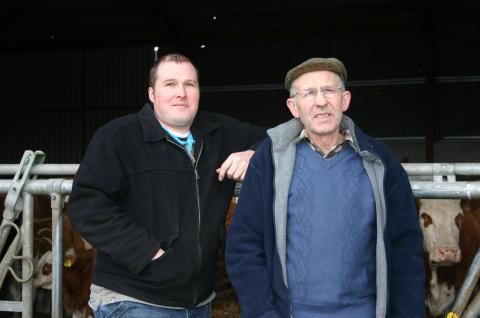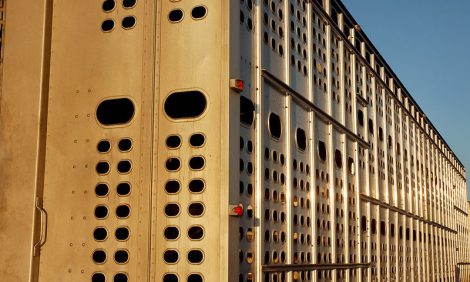



Forage Testing and Selenium For Cow Fertility, Workshop Advises
A Scottish beef operation has hosted a workshop looking at maximising fertility and production highlighting the importance of minerals and trace elements and forage testing.
The farm sits in Cairngorms and is run by George and Fiona Gordon and their son Charles.
The Gordons run a spring calving herd of 30 cows, plus two groups of 40 bulling heifers, some home-bred, but the majority purchased in local store auctions.
One batch of heifers calve in early spring with the other in mid to late summer. Other than a small number of the spring calving heifers retained as herd replacements, these heifers are sold with their two to three month old Limousin cross calves at foot.
There was also an autumn calving herd of approximately 60 cows, but as these calved in 2013, they were sold with calf at foot.
In recent years the Gordons have farmed over a number of units including a mixture of secure tenancy, short limited duration tenancies (SLDTs), a seasonal grazing and cropping agreement plus a regular grass let.

Last summer, the Gordons learnt that when the SLDT on one 150 acre unit, which included good cattle accommodation, expired at the end of the year (2013), it would not be renewed. This helped to encourage the decision to sell the autumn calvers.
Shortly after the recent monitor farm meeting, the Gordons were advised that 160 acres of Forestry Commission-owned grass at Rhynie, where they have summer grazed sheep for a number of years, will also no be longer be available. “This obviously means that we’ll have to make even more changes to our farming system,” commented Charles Gordon.
At the monitor farm meeting, Chris Barclay of Feedmix Ltd of Turriff, emphasised the importance of maintaining mineral and trace element levels in breeding cattle and recommended the testing of conserved forage.
*
"Selenium is needed for muscle development, liver function and colostrum quality"
At an earlier meeting the group had discussed the notorious lack of selenium and copper, plus excessive levels of molybdenum in the local Donside soils.
“Selenium is needed for muscle development, liver function and colostrum quality, with good quality colostrum helping to develop the calf’s immune system,” said Mr Barclay. “Dams vaccinated with Rotavec prior to calving pass on the defence against Rotavirus to their calves via their colostrum.
“Low selenium levels can also result in cows retaining their cleansings.”
Even when there are adequate copper levels in an animal’s diet, the high levels of molybdenum in the Donside soils can lock up the copper and reduce its absorption by the animal.
“Copper has a major effect on fertility,” explained Mr Barclay. “It is the spark to the start of cycling.
“Iodine, a constituent of thyroxin, a hormone secreted by the thyroid gland, is also important for reproduction as well as helping to generate the breathing reflex in a new born calf,” he added.
Monitor farmer Charles Gordon told the group that he used to spray iodine onto the flanks of his breeding females so they would ingest it by licking it off.
“Now we give them a slow release bolus which supplements copper, iodine, selenium and cobalt levels while helping to counter the high level of molybdenum, which we know can create problems. The boluses are far better and more effective than what we were doing before.
“Also before calving, the heifers and cows get pre-calver tubs which are high in trace elements. They include selenium, iodine and cobalt to help give the calves some vigour when they’re born.”
Conception rates in the Gordons’ females are excellent. At the June 2013 monitor farm meeting, the community group had viewed 40 bulling heifers running with a Limousin bull. These 40 heifers were pregnancy diagnosed on 30th December.
“There was just one heifer empty,” said Charles Gordon. “When the vet examined her, he established that she was a non-breeder, so the bull couldn’t have done more!”
The 30 spring calving cows were also pregnancy diagnosed on the same day, with three not in-calf.
“The cows and calves stay inside until the 1st of June. Once the cows have calved they get silage, a kilo of barley and beef cow minerals until they’re turned out,” explained Mr Gordon. “This helps to build them up for the bull which goes into the cows the same day they go out.”
At a monitor farm meeting on the Isle of Mull, Ian Pritchard, Beef Specialist with Scotland’s Rural College (SRUC), had highlighted the financial benefit of cows conceiving as soon as possible after introduction to the bull. He had told the group that each missed cycle resulted in a loss of approximately £50 per head in the eventual value of the calf.
For the 2013 calving of the Gordons’ 30 spring calvers, 26 calved within the first two cycles, with 17 calving in the first cycle.
Chris Barclay reminded the group of the importance of hygiene in calving areas when calving indoors. In addition to the prompt removal and disposal of cleansings, he also recommended scattering disinfectant powder around calving (and lambing) areas.
“A creep area for calves, whether or not they are being fed, also gives them a clean and safe haven, especially if bulls are running with their dams,” he said.
“Young calves have not had the chance to develop a strong immune system, so a clean lying area helps to reduce the risk of infection from things like cryptosporidium or Johne’s disease.”


